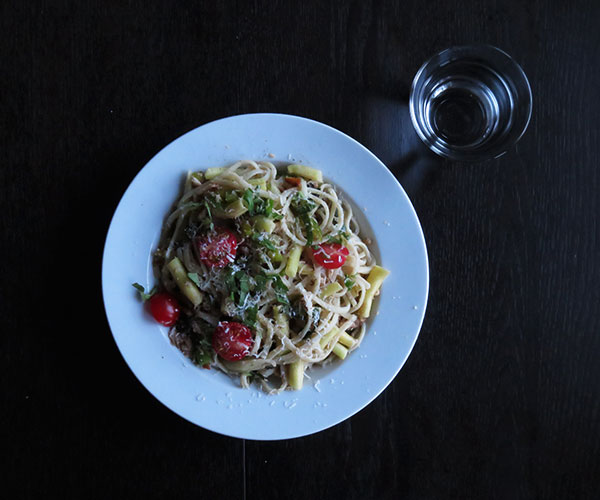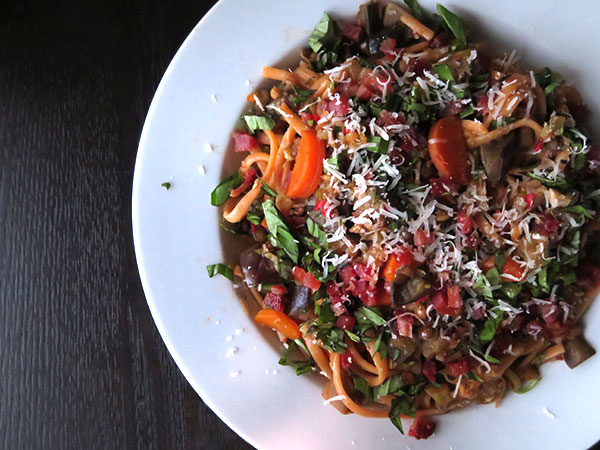Pasta gets a bad rap. Anyone can make it. Everywhere serves it. There’s nothing new about it. It’s boring, especially healthy pasta. The only way to make it taste good is to drown it in sauce.
But I think that’s unfair, and here’s why:
-
Pasta is limitless in its variability which, by the way, is the opposite of boring.
-
Dried pasta is one of the only convenience foods that contains two ingredients. Flour and water, that’s all. That’s hard to come by when you’re buying processed foods.
-
There’s a pasta for practically every diet. (Even low-carb diets have spaghetti squash and zoodles.)
The key to doing pasta right is to keep a variety of shapes and sizes in your pantry. Even better if you can keep stuffed pastas, like ravioli, in your freezer. Every main course pasta dish should contain fat, vegetables and protein. After that, no rules. Lots of sauce, chunky or pureed, or just a slick of oil with a pile of vegetables. Bits of meat, seafood, cheese and legumes are all fantastic additions. Even fried eggs are a common topping.
My Monday Night Pasta
As part of my CSA box this year, I get a weekly fresh pasta share from Bellingham Pasta Company. I make pasta regularly, but I rarely follow a recipe. Yet without new pasta ideas, it’s easy to fall into the same routine. I use my kitchenlister account to find easy pasta dishes. The ever-changing variety of veggies in my farm share also helps to keep it interesting.
Take tonight’s dinner for example. This week I received fresh lemon black pepper linguine. Since I was out of town over the weekend, I also had quite a few ingredients left to use up from Thursday’s box. In my kitchenlister account, I scanned through my pantry list for fresh produce. Just reviewing the list prompted me to start creating the pasta recipe in my head. Picking out the most perishable first, I also chose extra items to add. The pasta dish would include basil, string beans, green bell peppers, cherry tomatoes and garlic.
At this point, I could have gone to the kitchen and made a vegetable pasta meal. Deciding instead to consult my recipe list, I saw this penne pasta recipe. I had made it before with canned tuna. This time, however, I was out of tuna. I could still make a variation on the recipe using the suggested substitution. The tool recommended smoked whitefish because I do have that in my freezer. My next step could have been to look at the recipe link, but I didn’t need to. I was satisfied with my final list of ingredients. I felt confident about putting together a tasty and healthy pasta dish. Here’s the final result:

Easy Pasta, Twice in One Week
Well, if you thought pasta was boring before, I’m sure twice in the same week isn’t going to inspire you. Yet with my weekly fresh pasta share, it’s a summer staple for me. The truth is, though, I eat dried pasta a lot in winter so it’s not simply that I have to eat pasta right now. In any case, a new box on Thursday means a fresh supply of vegetables for Friday (and more pasta!). Remember though, this is local and seasonal eating. Not every vegetable will be different from the previous week. All the more reason to get creative with your cooking.
In the end, my Friday dinner was roasted red pepper linguine. It was topped with a slew of fresh ingredients: eggplant, carrots, leeks, and tomatoes. I sautéed the vegetables together with a little garlic and olive oil. The plated pasta was garnished with fresh basil and Parmesan cheese. Oh and that last little strip of bacon saved from breakfast.

Two summer pasta dinners with lots of farm fresh vegetables. Both easy and healthy. It’s hard to complain about this Monday-and-Friday pasta routine.
Keys to Success
Pasta is an easy and convenient dish to start improvising. The hardest part is the timing, but don’t stress over it too much. Most vegetables are forgiving that way; underdone or overdone, they still taste good. You might find your pasta is finished cooking before your sauce and vegetables are ready. In this case, add some olive oil or sauce to the cooked pasta so it doesn’t stick together. Most importantly, make sure to add enough salt. We tend to forget (or perhaps, don’t even realize) how much sodium is in most processed foods. The healthy pasta dinners here are made from fresh or frozen vegetables instead of jarred sauces. You will need to add more salt than you expect. A perfectly seasoned sauce may result in a bland dish, so taste again after adding the pasta. Some grated Parmesan and ground black pepper are almost always the right finishing touches.
Successful pasta dishes are colorful and vibrant. Rather than a parade of spaghetti and meatballs, good pasta meals reflect the season. Lots of fresh vegetables in summer is perfect—an easy time to go light on the sauce and heavy on the produce. A marinara or ragù made from canned or frozen tomatoes is better suited to winter. With limited fresh options available locally, the cold temperatures call for this hearty comfort food.
How to Cook Pasta (An Opinionated, If Lazy, Method)
How to cook pasta is a surprisingly controversial topic. My quick answer is to experiment, then do whatever you want. Still, to limit your trial and error, here are a few of my cooking tips:
-
The consensus is cooking pasta should involve a large pot and lots and lots of water. While I don’t disagree with this method, my 3.5-quart pot is just too convenient not to use. Plus it’s faster. I cook 1/2–1 lb of pasta in 2 quarts of water.* I think the next couple points are much more important than the amount of water used.
-
Add salt. Plenty of it. By this I mean, take a large pinch or two and throw it in the pot when the water comes to a boil.
-
Stir immediately after adding the pasta. Then frequently thereafter. More than anything else you do, this will keep your pasta from clumping together.
-
Assuming you brought the water to a boil over high heat, don’t turn it down after adding the pasta. I leave the pot on high the whole time and only turn it down if it’s about to boil over.**
-
Use the cooking time given on the package as a guideline only. Taste the pasta to decide when it’s done.
Note these are only my opinions. I’m sure someone else will find many of them objectionable. In all honesty, I just do not care that much about cooking pasta. It’s more important to me to buy a good brand (quality pasta makes a huge difference) and make a tasty and healthy sauce.
But Really, Is Pasta Healthy?
With the low-carb craze, you might think that healthy pasta is an oxymoron. I disagree. Not only is there a wide selection of what works as “pasta”, but you have control at every step. Cut the calories in your meal by changing the ratio of pasta to vegetables and sauce. It’s simple. Cook less pasta. Add more vegetables. In fact, “add more vegetables” is often the answer when it comes to making healthier meals.
*I also do the highly frowned upon practice of breaking long strands when they don’t fit into my too small pot. So perhaps you shouldn’t take my advice.
**To give credit where it’s due, this tip actually comes from my husband. He usually cooks the pasta in our house for no other reason than I just don’t want to. Since I’m at the stove anyway to finish the sauce, I’m responsible for frequent stirring.
READY TO GET INSPIRED BY ALL THE QUICK AND EASY RECIPES IN KITCHENLISTER? TRY IT OUT WITH A FREE ACCOUNT.
The two pasta dinners detailed in this post were part of my Week in Review meals for August 29–September 2, 2016.
